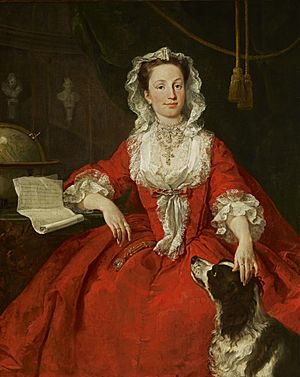Mary Edwards (1705–1743) facts for kids
Quick facts for kids
Mary Edwards
|
|
|---|---|

|
|
| Born | 1704–1705 |
| Died | 23 August 1743 (aged 38–39) |
| Nationality | British |
| Occupation | Businesswoman |
| Known for | "the richest woman in England" |
Mary Edwards of Kensington (born around 1704 – died August 23, 1743) was a very rich English woman. She inherited a huge fortune and was known as one of the wealthiest women in England. Mary was also a big supporter of the arts, especially the painter William Hogarth. Her life was quite unusual for her time, as she made her own choices about her relationships and money.
Contents
A Life of Wealth and Independence
Mary Edwards was likely born in London around 1704 or 1705. Her mother came from a Dutch family. Her father, Francis Edwards, was a wealthy landowner. He owned large areas of land in many parts of England. He also had shares in the New River Company, which supplied water to London.
Becoming the Richest Woman
When her father died in 1729, he did not leave a will. This meant his money would normally go to his wife, Mary's mother. However, Mary's mother decided to give the entire estate to Mary instead. At just 23 years old, Mary inherited a fortune. It was estimated to be between £50,000 and £60,000. This amount would be worth about £8 million today. This made Mary Edwards the richest woman in Britain at that time.
Her Relationship with Lord Anne Hamilton

Mary fell in love with a man named Lord Anne Hamilton. They reportedly married secretly around 1731. This marriage was said to have happened in a chapel at the Fleet Prison. News of their marriage was even reported in a magazine called The Gentleman's Magazine. However, Mary Edwards later said the marriage never happened. She never used his last name.
Lord Anne Hamilton started using Mary Edwards's name and family symbols. In 1734, the famous artist William Hogarth painted a family portrait of them. It showed Mary, Lord Anne, and their son, Gerard Anne Edwards.
Mary's Bold Decision
Mary and Lord Anne later separated. Lord Anne was spending Mary's money too quickly. Mary then took a very unusual step for a woman of her time. She declared that she was a single woman and that no marriage had ever taken place. She even created proof to show this. Because of her decision, their son, Gerard Anne Edwards, was officially considered to have been born outside of marriage. However, this seems to have been planned. His baptism record from 1733 already listed his last name as Edwards and his mother as single.
Mary as an Art Patron
Mary Edwards had a close friendship with William Hogarth. She asked him to create some of his most important artworks. She became a significant supporter of the arts, which was uncommon for women then. Mary Edwards asked Hogarth to paint Southwark Fair in 1733. She also commissioned his 1742 painting Taste in High Life. This painting made fun of the very expensive and over-the-top fashion of the day.
In 1742, Hogarth painted another portrait of Mary Edwards. This painting is now in the Frick collection. The portrait shows Mary's wealth and strong personality. It uses symbols of power usually seen in paintings of men. She wears many diamonds to show her riches. She is shown with a large hunting dog, not a small lapdog. In the background are portraits of important English figures like Alfred the Great and Queen Elizabeth I. A paper behind her shows a message about individual rights from a play called Cato.
In October 1742, Lord Anne Hamilton married another woman, Anna Powell. He was not charged with marrying two people at once. This suggests that Mary Edwards and Lord Anne Hamilton were never legally married, even though they lived together and had a child.
Death and Legacy
Mary Edwards died in Kensington in 1743. She was buried simply next to her father in St Andrews Church in Welham. She had made sure her son, Gerard Anne Edwards (1734–1773), received an excellent education. She also left all her wealth to him.
In 1754, Gerard Anne Edwards married Lady Jane Noel. She was the daughter of Baptist Noel, 4th Earl of Gainsborough. Mary Edwards's son and his wife were the parents of Sir Gerard Noel, 2nd Baronet. He was an ancestor of the later Earls of Gainsborough.

